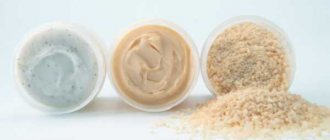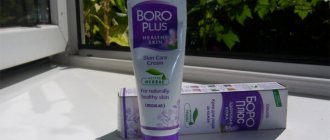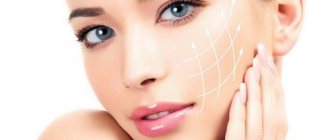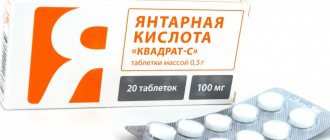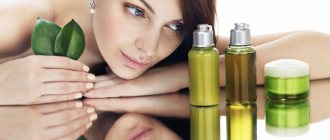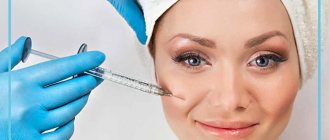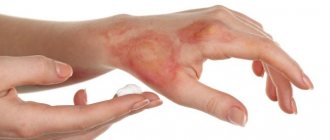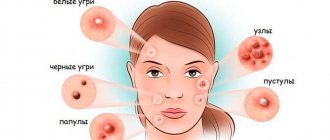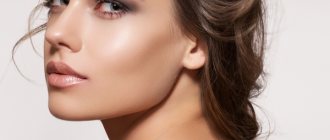Features of thin skin
If you study the properties of the skin, thin skin resembles dry skin. But there are certain individual characteristics. You can recognize thin facial skin by certain signs:
- there is no shine or greasy film on the face;
- has a matte velvety structure;
- the surface is smooth and does not contain enlarged pores;
- too tight, dry and flaky;
- there are capillaries near the surface, so the face may often turn red;
- due to insufficient amount of melanin, the face is too pale;
- bruises often appear under the eyes because veins are visible there;
- Irritation may occur due to a reaction to new cosmetics, smoky air, salt water, wind or frost, or the sun.
When a person is still very young, his coverings are distinguished by their neatness and good appearance. But after some time, her aging will occur much faster. Already at the age of 25, a person may experience the first wrinkles. Therefore, it is important to start proper care from adolescence.
Oily skin - how to properly care for it
Thanks to the increased secretion of sebum, oily skin does not age for a long time. Wrinkles appear on it quite late. Another advantage is reduced sensitivity. Those with oily skin can more easily tolerate more aggressive cosmetic procedures, such as deep peels, without the risk of irritation.
The main problems that arise in owners of such skin are acne, increased oiliness, enlarged pores, and blackheads.
Pimples
Products for oily skin:
- Cleansers with glycolic and salicylic acid - reduce sebum production, remove acne and reduce pores.
- Cosmetic products with vitamin A - normalize the functioning of the sebaceous glands, improve the color and appearance of the face.
- Antioxidant serums – prevent aging.
- Light moisturizing creams and cosmetics with hyaluronic acid - moisturize without adding grease or clogging pores.
Recommended treatments for oily skin:
- Laser procedures have a bactericidal effect and prevent acne.
- Chemical peels – remove age spots, acne, and reduce sebum production.
- Cosmetic cleansing – eliminates acne, clogged pores, blackheads, which often form on such skin.
- Dysport/Botox fillers – remove wrinkles and dark circles under the eyes, making the oval of the face better defined.
Chemical peeling
Proper care will remove oily shine from the skin, tighten pores and avoid the appearance of acne.
Factors that harm thin skin
Integuments, their condition depends on heredity, but there are also certain factors that can harm the skin of the face. If you want your skin to be young and healthy for as long as possible, then pay attention to the following factors:
- prolonged exposure to sunlight. Due to ultraviolet radiation, collagen, which is located in deep layers, is destroyed. The same goes for elastin, which causes the skin to become less elastic. Pigment spots may then appear. To minimize the risk of skin damage, you need to use products with SPF filters. In this case, the protection level indicator must be at least 30 units or more;
- Peeling for thin facial skin is not recommended. When you remove cells from the epidermis, it takes nutrients from the dermis to repair itself. Because of this, the deep layers lose their thickness, the skin sags, and wrinkles appear. After peeling, the skin becomes more sensitive. It is better to replace this option with gommages, which are more gentle;
- too active facial skin care. The dermis after procedures using a laser or chemical cleansing can become thinner by 30%;
- the use of cosmetics that promote exfoliation. You should not take products that contain tartaric, lactic, glycolic, or salicylic acid;
- long-term use of topical steroids. They are taken when it is necessary to cure dermatitis, but such products make the skin thinner.
If a person also has low estrogen levels, then the above factors and their effects will be more noticeable. The skin on your face will be dry, sagging, and wrinkled.
Causes and symptoms
Loss of skin tone and elasticity is associated with many factors, including:
- age;
- stress;
- bad ecology;
- lack of vitamins and minerals;
- unbalanced diet;
- lack of hydration;
- presence of bad habits;
- incorrect selection of care products;
- lack of physical activity;
- genetic predisposition;
- hormonal changes in the body.
The collagen contained in it is responsible for the elasticity of cells. Over time, collagen becomes thinner, cell renewal slows down, and the skin becomes thinner, causing wrinkles and folds to appear.
External manifestations of loss of elasticity are expressed in the appearance of wrinkles, enlarged pores, and age spots. The skin loses its healthy color. It slowly returns to its original shape when pulled back. It is impossible to stop this process completely, but with the help of proper care and cosmetic procedures it can be slowed down.
Recommendations for thin facial skin
It is very important to properly care for your facial skin every day, so you should follow certain expert advice:
- do not use ordinary soap, it is better to take special milk or gel;
- do not go to bed with makeup on your face;
- regularly use masks and creams;
- the products should not contain aggressive, alcohol-containing components;
- remove salty, fried, spicy foods from the diet, and add more nuts, vegetables, fruits;
- do not perform aromatherapy, do not make herbal compresses, do not use cosmetic ice;
- Do not stay in the sun for too long, do bath procedures, or visit the sauna;
- sleep enough time so that cells can renew and recover;
- control your facial expressions, try not to wrinkle your forehead or squint your eyes;
- drink plenty of water;
- use sunscreen;
- If you decide to do peeling, then use exfoliating microgranules of artificial origin. They will injure the skin less.
Combination skin – a cosmetologist will help you care for it
In this case, dry or normal areas alternate with oily areas located in the nose, forehead and chin. There is no “typical” behavior for this type - it all depends on the specific combination of areas. Its condition may fluctuate depending on the season, hormonal changes, stress, etc.
Recommended products for combination skin:
- In winter. Products that combat cold and dryness, which often occurs due to a long stay in a room with central heating.
- In summer. Moisturizing cosmetics that prevent aging.
- Always. Products with vitamins, growth factors, peptides and antioxidants that improve the condition of skin structures.
It is recommended to use a rich cream on dry areas and a light moisturizer on oilier ones. That is, owners of such skin will need several care products.
Applying a rich cream on dry areas
Ideal procedures:
- In this case, there are no uniform recommendations - they differ for each patient. For most people, plasma injection, mesotherapy, and facial cleansing are suitable in case of acne and other skin manifestations associated with clogged pores.
- For such skin, preparations based on botulinum toxin are recommended - Dysport, Botox and their analogues, fillers (fillers) based on hyaluronic acid and other components.
It is very difficult to choose the right methods for caring for combination skin - only a cosmetologist can do this. Trying on your own can cause serious harm.
results
Individual hand dominance and preference for using the right or left hand were also analyzed. In 304 (98%) women, the right hand was dominant, in 7 (2%) the left hand was dominant.
300 (96.5%) women preferred to use the non-dominant hand, which is more aesthetically pleasing. Since the dominant hand is used mainly for physical labor, it can be expected to age at an accelerated rate. When surveyed, the majority were aware that hands differ in appearance, but most did not attach any importance to this. In the hand of the dominant hand, congestion, veins, and muscles were more pronounced, and the shape was more reminiscent of a square.
Women placed more importance on the aesthetic appeal of the non-dominant hand.
Among the proposed eight signs that define an “aging hand,” patients identified four main ones: age spots, contouring of veins and tendons, sagging/wrinkling, thinning of the skin (in 87, 84, 78 and 76%, respectively).
In this study, a group of women over 40 years of age was identified ( n
=208) with signs of chrono- and photoaging, three main
morphotypes of aging
of the dorsum of the hand were identified, correlated with age, BMI, and fold thickness (Fig. 3).
Rice.
3. Morphotypes of hand aging. The morphotype of hand aging is a set of constitutional and age-related features of the dorsum of the hand, including shape-forming characteristics, involutional changes in the skin, the severity of subcutaneous tissue atrophy, visualization of veins and tendons.
Type I - atrophic/asthenic morphotype
(31%,
n
=134) occurs in women with an asthenic type of constitution and a BMI of 18-19 kg/m2 of veins and tendons. The skin fold of the dorsum of the hands is thin (1-2 mm), the skin is thinned, dry, wrinkled, subcutaneous fat tissue (SFA) is poorly developed. With the pinch test, the skin straightens out in 4-8 seconds. The circular folds in the wrist area are thin and shallow. The longitudinal size of the rear of the hands, as a rule, prevails over the transverse one, the phalanges are long or of medium length.
In this type, patients with venous and tendon components can be distinguished.
Venous component
very pronounced (for a correct assessment of the filling of the venous network, the study subjects were seated vertically, with the arm bent at the elbow joint at an angle of 90°).
Characteristic is the tortuosity of the vessels, which increases with age, and incomplete emptying of the veins is observed during flexion of the fingers.
During the survey, we found that 45% of women do not associate veins with age. Flexor tendon contouring and venous tortuosity (venotendinous subtype) have been found to be genetically determined; Features of the back of the hand attracted attention already at a young age and were found in the mother. This subtype in our study was identified only in 7.9% ( n
=8).
During the survey, many women noted that the pattern of the dorsal veins changes little with age. The severity of the veins increases from physical activity, after wearing heavy objects, and also due to the characteristics of the profession (the hands of a pianist, violinist, waitress, cleaner).
It was noted that atrophic changes in the tissues of the dorsum of the hands with contouring of the tendons occur closer to the metacarpophalangeal joints.
Tendon component
: tendons are visible on the back of the hand, especially clearly visualized above the center of the metacarpophalangeal joints of the II-IV fingers, especially noticeable during flexion. A direct correlation between the progression of the degree of aging and age was revealed.
Type II - normotrophic morphotype
(48.1%,
n
= 154) occurs in normosthenics with a BMI of 19-24 kg/m2, less often in asthenics. The skin is thin, the skin fold is of medium thickness (2-2.5 mm), with a pinch test it straightens out in 5-7 seconds. The pancreas is moderately developed. Veins and tendons are poorly or moderately visualized. The venous component is often due to genetic or occupational characteristics. During flexion of the fingers, the dorsal veins are completely emptied. With age, multiple transverse flexion folds over the proximal interphalangeal joints (PIP) and a separate fold over the distal interphalangeal joints (DIP) may occur. The circular folds of the wrist are more pronounced. The longitudinal and transverse dimensions of the rear of the hands are close or the longitudinal one slightly predominates, the phalanx is of medium length.
Symptoms of sagging, dry skin, according to our observations and according to patient complaints, appear and progress after 50 years. It is the deterioration of skin quality due to a decrease in its visco-elastic properties that worries patients with this type of aging of the hands.
Type III - hypertrophic morphotype
(20.4%,
n
=23) occurs in women with a hypersthenic build, with a BMI of 25-30 kg/m2. The subcutaneous fat layer of the dorsum of the hands is also well expressed both on the face and torso. The skin fold is difficult to grip and its thickness is above average (2.5-4 mm). The fold quickly (within 3-4 s) returns to its original state, completely straightening out. In the hands of overweight people (BMI>27 kg/m2), there is more superficial fat in the dorsal superficial plate, which masks veins and other deep structures.
Veins and tendons are practically not visualized. Multiple transverse flexion folds over the PIP and a single fold over the DIP may occur. The back of the hands is characterized by a square shape, the phalanges are short or medium in length.
Wrinkles are weakly expressed and dynamic in nature.
Patients of this type of hand aging are the least likely to seek cosmetic treatment for this area. To restore skin moisture and elasticity, short courses of biorevitalization with stabilized hyaluronic acid preparations can be recommended. Fillers are not recommended for this type.
We noted that signs of photodamage to the skin (dullness, pigmentation, lentigo) occur in all identified types of aging. Their number increases with age and does not depend on BMI; they correlate with age and photoaging of the face (see Fig. 3). The number of age spots increases with age (high positive correlation coefficient). Single age spots may first appear in the fourth decade; later they merge with each other, increasing in size and number. After 60 years, the spots are quite numerous (Fig. 4).
Rice. 4. BMI and stage of aging.
Clinical differences in morphotypes of aging hands are presented in the table.
Clinical differences in morphotypes of aging hands Note. + - mild degree of severity of the symptom; ++ - average degree; +++ - pronounced degree.
Material and methods
To identify and describe various morphotypes of aging, we developed a questionnaire consisting of four blocks of questions that revealed information about heredity, morphometric data, clinical signs of aging, self-assessment of the condition of the skin and soft tissues of the hands. A 10-point rating system was used, in which the significance of a feature was determined from 0 to 10 (with explanations). The questionnaire was filled out by the patient and an independent medical expert. Filling out the questionnaire took about 5 minutes.
We also collected information about hand dominance at work, profession, preference for using the right or left hand, calculated BMI, and determined the morphotype of aging in interviewed individuals over the age of 40.
At the Vallex Med clinic, from November 2014 to November 2016, a study was conducted in which 310 healthy women of the Slavic type who were cosmetology patients took part. Questionnaires and questionnaires for the subjects were approved by the ethics committee of the Vallex Med clinic.
Inclusion criteria: healthy women aged 25-65 years of Slavic type, I-III phototype, with a BMI of 18-30 kg/m2.
Exclusion criteria: skin, rheumatic diseases, gout, deforming arthritis, various types of injuries to the hands (burns, fractures, scars in the hand area, neurovascular disorders), previously performed cosmetic procedures in the area of the back of the hands.
Standard photography of both hands was performed in oblique radial and dorsal projections in full size, as well as from above during flexion, in the same room with constant temperature and lighting, with the same camera. The photographs were assessed by the same expert (cosmetologist) using the merz scale.
The photographs were assessed and the dominant signs of aging for each participant were identified.
Subjects were weighed and height measured to determine BMI. Next, we measured the length and width of the brush; wrist circumference. Information was collected about the dominant hand, the time of appearance of signs of aging in the area of the back of the hands, and the hereditary nature of skin aging in this area.
At the next stage, the severity of contouring of veins and tendons, loss of volume of the pancreas, and pigmentation were assessed.
The most standard options for aging brushes were selected, and trends in brush aging were determined from photographs.
Test to determine wrinkles and sagging.
The patient's skin was gathered into a fold in the center of the back of the hand (above the area of the third finger) in the longitudinal and transverse direction (pinch test). They raised it above the level of the back of the hands and measured the time during which the skin returned to its original position, and also measured its thickness using a caliper with an accuracy of 0.2 mm.
Conclusion
God's handiwork in creation is evident in everything He has made, even in our skin. Like many things, we take the skin's protective functions for granted. But let's thank God for our skin, which is so important to our lives. First of all, let us give thanks to our Lord and Savior, who forgave those who plunged the crown of thorns into the skin of His forehead and tore the skin of His back to shreds. By His stripes we are healed from sin, death and hell (1 Peter 2:24).
“And I know that my Redeemer lives, and on the last day He will raise this decaying skin of mine from the dust, and I will see God in my flesh. I will see Him myself, my eyes, not the eyes of another, will see Him..." (Job 19:25-27)
